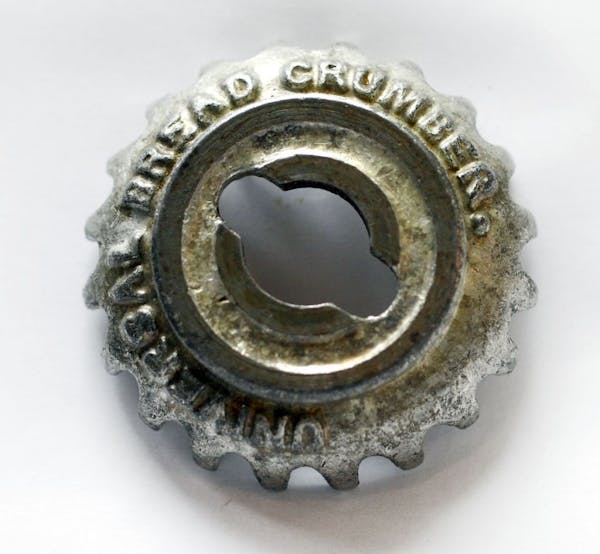My grandmother's meat grinder, 90 years old, looks almost the same as the deluxe heavy-duty grinder that I recently pulled off the shelf at Ace Hardware in downtown Robbinsdale. Which is to say it looks fearsome, if not downright dangerous, with its 3-inch auger that seems suited for drilling holes in the ice. Her model, made of cast iron and clearly marked with the brand "Universal," fits tightly into a wooden box for storage, with multiple disks that easily turn the machine into a "bread crumber" one moment or a "nut butter grinder" the next, the descriptive words cast in iron on the individual pieces. Likely a wedding gift for my grandparents in the early 1920s, the grinder has sat on my pantry shelf for more than a decade, tempting me to figure it out. But despite my best intentions, I had forgotten about it.That is, until images of pink slime and FTB (finely textured beef) prompted me to tear apart my pantry in search of the wooden box. ("I know it has to be here somewhere," I muttered as I searched. And it was.)
A very long history
The Universal grinder was first designed in 1897, at which time it transformed the work of the cook by easing the effort required to chop meats and vegetables. The simple machine could grind 21/2 pounds of meat per minute, depending on the agility of the person turning the handle. It was nothing short of a marvel -- a food processor for the 19th century.
More than 100 years later, the design of the hand-cranked version hasn't changed. It's still made of cast iron, which must be clamped or bolted to a work surface. The auger -- the giant screw that pulls the meat into the blade -- still looks formidable. Indeed, the only apparent difference is that my new one includes operating instructions, along with these warnings:
"KEEP FINGERS CLEAR of the Auger and Plate at all times. NEVER reach into any Grinder inlet."
"DO NOT use the Grinder while under the influence of drugs or alcohol."
True enough, though I've discovered that the hand-cranked grinder is, in fact, not scary at all once you've tried it.
There are other types of grinders these days, all of which can also be used to make (and stuff) sausage; some attach to electric mixers, others are electric versions of the century-old model.
My heart, though, is with the old-fashioned variety, which is relatively inexpensive ($43 for my new version and perhaps available in yard sales or thrift stores) and easy to operate, once you get the hang of it. After I'd put the grinder together, which only took moments, I dropped 2 pounds of stew meat into the chamber. After some cranking on the handle (it's a great upper arm workout), the meat was through the grinder in minutes.
But I didn't stop there. I added thick-cut smoked bacon, chopped in large chunks, to the mix -- because when you're grinding your own meat, you can add whatever you want. Then I ran it all through the grinder a second time, to tenderize the meat further. The whole process took less than 10 minutes, much longer than necessary because I stopped periodically to take photos and to exclaim, "This is so cool."
I remember that my grandmother made hash from roast beef leftovers with her grinder, dropping beef chunks, cold boiled potatoes and chunks of onion into the machine. "Then she would put it all in a casserole dish and bake it until it was all crusty," my mother told me, as she moaned, "It was my favorite meal."
I'm not the only one who leans toward carefully ground meat. Erick Harcey, chef-owner of Victory 44 in Minneapolis, has a butcher shop doing a custom grind for the restaurant's burger. "We go through half a cow every 10 days," he said. "And we have a little bit of bacon ground into it." He uses the entire half cow in his burger blend, rather than a specific cut. "It feels like a more natural balance with that," he said.
Gordy Lindenfelser, owner of Hackenmueller Meats in Robbinsdale, grinds hundreds of pounds of meat as a normal course of business. For those doing the grinding at home, he suggests using choice chuck. For his batches of burger at the shop, he uses choice trim along with cow knuckles. "Make sure the meat is cold when you're grinding it, to keep it firm," he said. When grinding turkey, he notes, don't add fat or bone to the mixture.
As for me, I'm smitten by the marvel of the meat grinder and by the notion that my hamburger can come from one animal, or two.
Next on my to-do list? Making bread crumbs with it. And who knows? Nut butter may follow.
Follow Lee Svitak Dean on Twitter: @stribtaste

A wild week in restaurants with 4 closings and an opening
The Rolling Stones set to play New Orleans Jazz Fest 2024, opening Thursday

